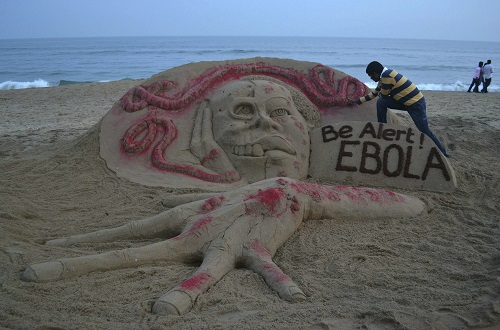
A 35-year-old man, suspected to have been infected with Ebola, has died at AIIMS hospital in New Delhi.
However, primary reports show that the patient, a native of Jodhpur, was suffering from Crimean-Congo Haemorrhagic fever (CCHF), a tick-borne viral disease, and died of internal bleeding.
"It appears to be a case of CCHF, which is also highly contagious and can spread with close contact with the blood, secretions or other bodily fluids of infected persons," a doctor told The Economic Times.
He was airlifted to New Delhi on Tuesday after complaints of high fever, disorientation, vomiting and severe weight loss, The Tribune reported.
Doctors ruled out chances of Ebola as the patient had no history of travelling to the disease-hit West African countries.
Moreover, Ebola tests conducted at the National Centre for Disease Control in New Delhi came back as negative.
A statement released by the Ministry of Health and Family Welfare confirmed the reports and said that they have received similar cases of viral haemorrhagic fever from Jodhpur.
Reports showed that one of the patients, who had developed thrombocytopenia as well, died in a private hospital in Jodhpur on 18 January.
Samples collected from the two patients have been sent to the National Institute of Virology in Pune for further testing.
Rajasthan and Gujarat have been placed on high alert and efforts to spread awareness about a possible outbreak of CCHF have already begun.
"The health authorities of Gujarat and Rajasthan have been alerted for a possible diagnosis of Crimean Congo Hemorrhagic Fever (CCHF) and the guidelines have been shared with these states," the statement on the official website of the Health Ministry read. "A three-member team of experts from National Centre for Disease Control, Delhi is visiting Jodhpur, Rajasthan for outbreak investigation and providing public health support to the State health authorities."
What Is Crimean-Congo haemorrhagic fever (CCHF)?
Crimean-Congo haemorrhagic fever (CCHF), according to the World Health Organisation (WHO), is a deadly disease caused by Nairovirus of the Bunyaviridae family. Domestic animals like cattle, sheep and goats, sometimes, carry the virus. But, the infectious disease is primarily spread by hyalomma ticks and can cause death in 40 percent of the cases.
The disease is spread to humans through tick bites or exposure to animal blood or tissues.









